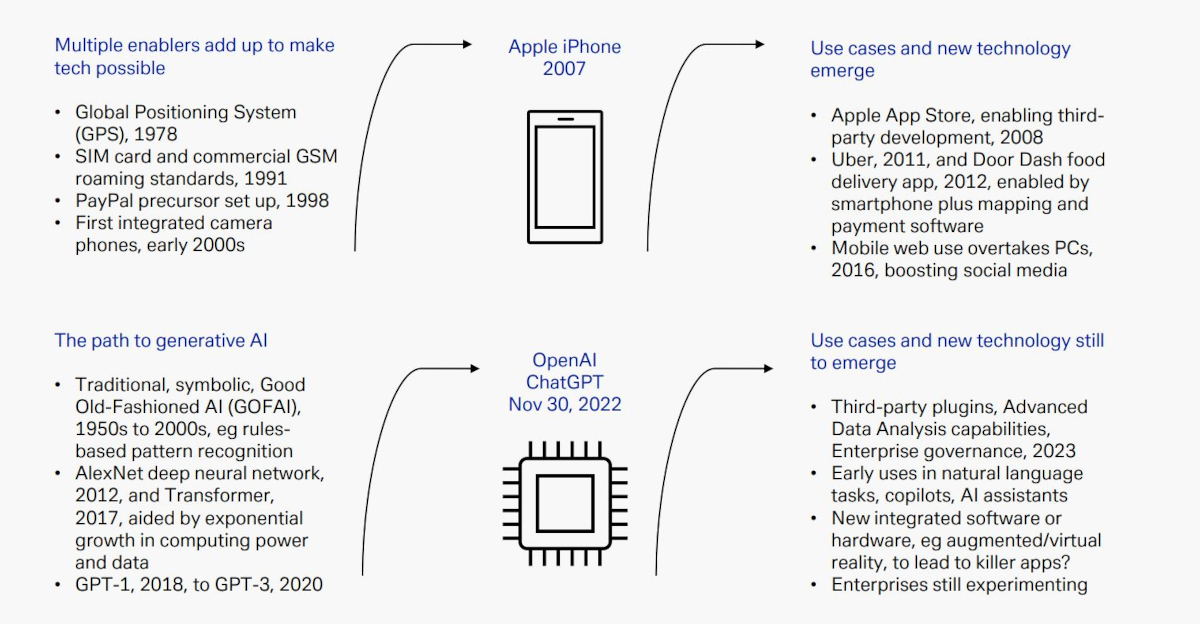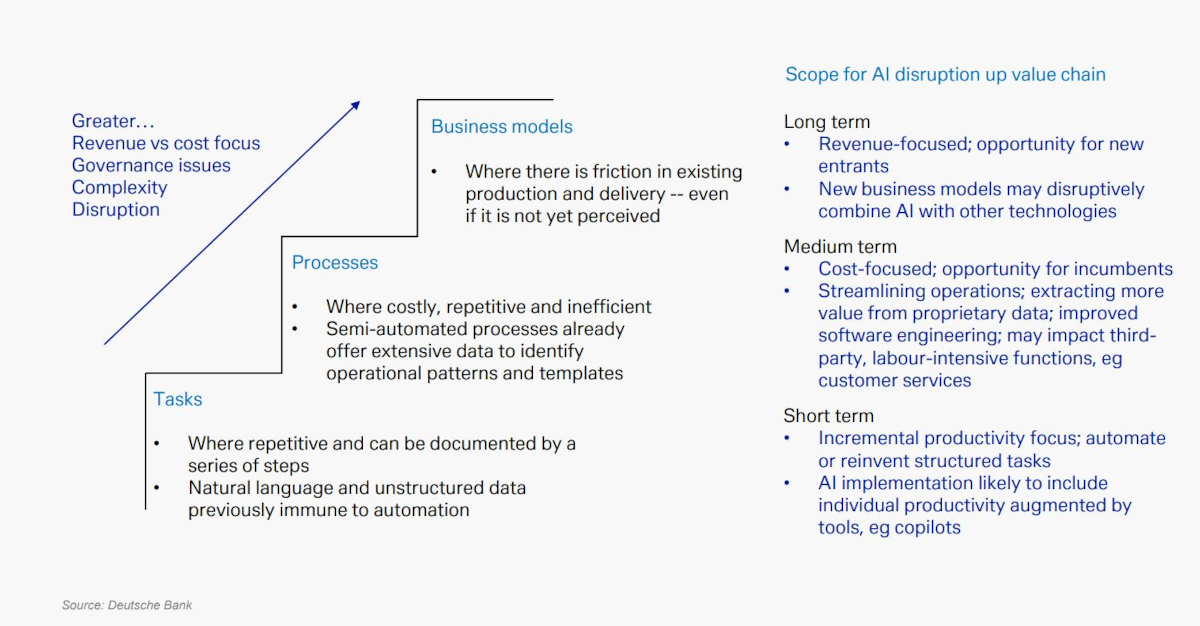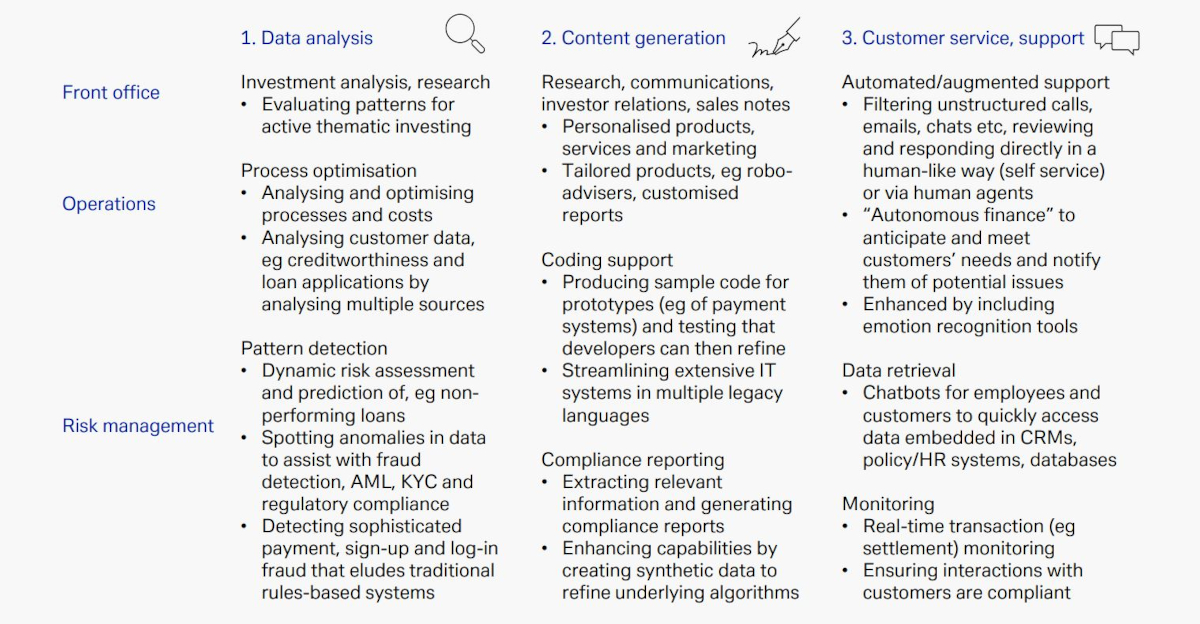8 February 2024
Why is everyone talking about artificial intelligence (AI) and ChatGPT but with little to offer in the way of practical application? Is it a revolution in waiting? flow reports on some analysis from Deutsche Bank Research Strategists Adrian Cox and Galina Pozdnyakova
MINUTES min read
On 30 November 2022, amid much publicity, Chat Generative Pre-Trained Transformer, aka ChatGPT, was launched by OpenAI, a US company set up just seven years previously by Sam Altman, Elon Musk and others.
ChatGPT is a language model-based chatbot that gives users the ability to determine the length, format, style, level of detail and language of a conversation to match their personal requirements. But one year on from its debut, “generative AI is everywhere and nowhere,” suggest Deutsche Bank Research analysts Adrian Cox and Galina Pozdnyakova in their recently published PositiveImpact white paper Where’s my AI revolution? Practical ways you can get less chat, more action.
The (so far) limited application of AI chatbots such as ChatGPT and Bard is due to the shortcomings of their underlying Large Language Model (LLM) technology, critics suggest. But as the report’s authors remark, the success of technology relies not only on earlier innovation “but also on people joining the dots and fitting it into a hardware and software framework that takes time to create and roll out.”
Unless those elements can be successfully united, the resultant mismatch is a 21st century equivalent of the Ancient World’s people of Mesoamerica, who developed wheeled toys and figurines yet apparently could not make the imaginative leap in then developing practical applications for the wheel as transport, such as carts and chariots.

© Image by DALL-E
While there is no shortage of resources for generative AI, the report suggests that the obstacles to its early use by enterprises are significant but identifiable as: technology and data, governance, and people. The authors explain how companies can overcome them and unlock AI’s many productivity and creativity benefits.
A revolution in waiting
“AI is getting smarter and better funded – and everyone’s talking about it,” state the authors. Yet while around two in three people in both the US and Europe have heard of ChatGPT and other AI assistants, only one in five has tried ChatGPT and enterprise use of generative AI remains limited and mainly experimental. Figure 1 outlines the three main obstacles that prevent an AI revolution from getting underway.
Figure 1: Three main obstacles to a corporate AI revolution
Source: Deutsche Bank
The history of innovation demonstrates that “no technology is an island,” note Cox and Pozdnyakova. So, while generative AI has many capabilities, such as opening up accessibility to software development and interaction “history shows it takes time for killer applications to evolve as capabilities are blended with new software and hardware.” They cite the example of the Apple iPhone: its launch in 2007 built on several preceding enablers that made the technology possible, including the Global Positioning System (GPS) first released in 1978, SIM card and commercial GSM roaming standards in 1991, the PayPal precursor set up in 1998 and the first integrated camera phones in the early 2000s.
Figure 2: The history of innovation shows no technology is an island
Source: Deutsche Bank
In the 12 months since the launch of ChatGPT, early-stage applications have included natural language tasks, but many of the potential use cases and the new technology to open these up and lead to “killer apps” have still to emerge as businesses continue experimenting. In Figure 3, the authors suggest areas of business that offer scope for AI disruption.
Generative AI initially promises to augment routine tasks and then to improve inefficient processes in enterprises. In due course, innovations will disrupt business models.
Figure 3: How can you use generative AI in your business?
Source: Deutsche Bank
Nascent uses for generative AI in financial services centre on three areas: data analysis, generating content, and customer service and support. Each of these can be utilised to improve the company’s front office, operations and risk management, as outlined in Figure 4 below:
Figure 4: Nascent uses for generative AI in financial services
Source: Deutsche Bank
To build, buy or partner?
Companies have three basic options to choose from when deciding how they will develop their AI capabilities. These are to:
- Build and create core AI solution using in-house capabilities,
- Buy. This means procuring software, APIs or use open-source code; or
- Partner. For example, teaming up with a supplier that already has the capability.
Successful capability development depends on five basic factors:
- Quality (accuracy and speed);
- The complexity of the solution;
- The effort required to implement and/or change it;
- Cost; and
- Security
Application of AI
The third section of the report offers a practical guide to applying generative AI, examining the three factors of technology and data, governance and people.
The first area involves several big choices, including whether the company necessarily requires the power of generative AI. “Traditional, rules-based, predictive AI is often cheaper, faster and more explainable than generative AI for well-defined tasks,” explain the authors. “Generative AI is more suited for open-ended tasks involving unstructured data and human-like creativity.”
“Very few people have used AI assistants at work but many fear that their tasks/roles may be augmented or automated away”
The next question for companies is how best to build intellectual property (IP) and leverage data. The former, the authors suggest, “will likely come not from horizonal LLMs but from vertical application; having reliable proprietary data will be a critical competitive differentiator when AI erodes the current advantages in processing it.”
On the issue of governance, chatbots alone may not be suitable for enterprises. The report suggests that both they and LLMs need to be part of a system that protects against shortcomings – including the possibility of employees inputting proprietary data that then becomes training data for the LLM.
Governance is also impacted by the uncertainty created by fast-evolving AI regulation. Since 2016 there has been a plethora of bills passed into law by national legislative bodies around the world in which the keyword is “artificial intelligence”. Cox and Pozdnyakova note that companies will want to comply – without going further than necessary – but “approaches are divergent, evolving fast and may apply extraterritorially.”
As for people, both managers and employees are unfamiliar with AI and are likely to have anxieties. “Very few people have used AI assistants at work but many fear that their tasks/roles may be augmented or automated away,” the authors observe. “Companies need to keep employees informed and train them to make the most of these knowledge-sharing tools.”
Customers also need to be convinced, with most preferring to still deal with an actual person and wary of AI. Research suggests that while genAI can improve customer service, it doesn’t yet command trust, which companies need to build “by improving service, protecting privacy and ensuring AI does not lead to biased decisions on, for example, mortgage approvals.”
The concluding message from the report: The wheels of the AI revolution are already turning – it will just take a little more time for the rubber to hit the road.
Deutsche Bank Research report referenced:
Where’s my AI revolution? Practical ways you can get less chat, more action, by Adrian Cox and Galina Pozdnyakova (November 2023)









